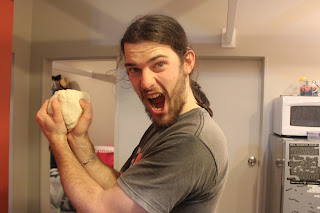Working with plaster to make casts of different shapes is going to be exciting, so I grabbed the first thing I could and cast some plaster into it. An old ice tray.
After a few hours I could get the icicle shapes out of the tray.
They are mostly good, there is a clean break in the weakest point of all of them. Maybe they needed a release agent. I Have been told that vaseline or any other lubricant can help get things out when you are casting certain materials. I'll hopefully be making some better moulds too.
Next I fill a container with plaster and make impressions in the plaster by pushing objects into it.
Scrape the bucket clean.
I used a golf ball.
A pine cone; this could be tricky to remove as the plsater will have seeped into all of the small grooves on its underside.

As seen here the pinecone mould did break, it could have been a lot worse though.
The golf ball mould is pretty good. If I had two of these I could cast something inside of each side and then stick them together to get a replica golf ball.
A brilliant idea found its way to me. Using lego bricks to set into the plaster.

Most of these came out pretty easily. The long yellow piece was slightly more difficult to manuevre out.
My next step is to fill the moulds with a casting resin to produce replica lego/duplo bricks.
Ultimately most of my plaster moulds broke.

Broken Pinecone Mould.
The lego moulds broke as I tried to force the yellow piece out, and when I tried to cast anything with Resin I managed to mix the resin incorrectly so it wouldn't set and just made a mess instead.
The ice cube tray strikes back, this time with poorly mixed resin.


 Cook for 40-60 minutes at 200 degrees C
Cook for 40-60 minutes at 200 degrees C






















































